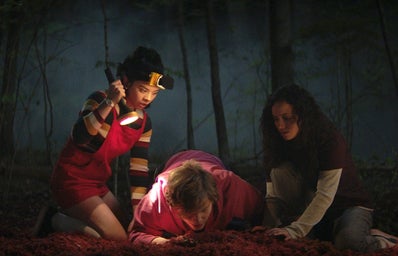Warning: This article contains spoilers for all three of the “Fear Street” films.
Though spooky season is long over, I am of the mindset that any time of year is a great time to watch a horror movie. Over Thanksgiving break, I spent most of my time in my pajamas on the couch with my family, which gave us the opportunity to watch a bunch of movies together. The “Fear Street” movies were some of the first ones we watched, and it reminded me of how much I loved watching these over the summer. Many films don’t hold up, but I was reminded of how enjoyable these movies can be on the second or third viewing.
The “Fear Street” trilogy took the world by storm in July, when the films premiered on Netflix over the course of three weeks. The films are loosely inspired by the book series of the same name by R.L. Stine, who is well-known for writing the Goosebumps book series.
“Fear Street: 1994” sets up the world of Shadyside, which is referred to as “Killer Capital, USA.” Numerous tragedies have plagued this town, leaving it struggling in comparison to Sunnyvale, Shadyside’s wealthy and successful neighbor. “Fear Street: 1978” looks deeper at one of the Shadyside slayings, and finally “Fear Street: 1666” examines the story of Sarah Fier. Fier was hanged for witchcraft in 1666 and this movie highlights the impact that her death had on Shadyside for centuries.
One of the biggest things these films accomplish is following characters that typical horror movies wouldn’t focus on. Horror fans know that the genre has many issues when it comes to representation. Most films are directed by white men and the characters are typically molded after stereotypes without any further dimensions. Therefore, this limits the opportunities for diverse characters to do much more than die in the first act.
This film turns all those expectations on their head, highlighting a romance following two girlfriends. Deena and Sam, played by Kiera Madeira and Olivia Scott Welch, respectively, portray a realistic couple that go through realistic problems during the trilogy. There is never any indication that their relationship is “perfect,” but it’s their fights and struggles that make viewers want to root for them. Deena, a gay woman of color starring in a slasher movie serves as a modern update to the “final girl” trope, which typically has a white, demure girl as the star of the movie.
“For me, that was about trying to tell stories about people that normally would not have been highlighted, even though, obviously, they existed,” director Leigh Janiak said in an interview with IndieWire. “There were queer people in the ’90s and ’80s and ’70s. There were Black people. There was a whole swath of people that are underrepresented in horror movies or die very quickly! That was an exciting part of the trilogy to me and built into why I wanted to make the movies.”
The films are also able to examine bigger topics without side stories taking over the entire plot. Horror movies have always had a history of exploring deep issues, such as race, class divide, and current issues and “Fear Street” is no exception.
In the first movie, Shadyside and Sunnyvale are set up as polar opposites, with Sunnyvale seeing success and safety while Shadyside always gets the short end of the stick. There is seemingly no escape for Shadysiders from this fate and many of them resign to the fact that their town is cursed. Both Deena and Ziggy Berman, the protagonists of “Fear Street: 1978,” have given up on any chance of escaping Shadyside and they represent the general feelings of all Shadysiders; that their lives are permanently plagued by trouble and there is nothing they can do about it.
It isn’t until the final movie in the trilogy that it is revealed that the Goode family’s deal with the devil has caused Shadyside’s struggles. Their ultimate oppression over Shadyside in order to ensure their own success and power feels all too similar to the upper class using those beneath them for their own personal gain. The sacrifices for this power come at the expense of Shadyside, allowing Sunnyvale to prosper and flourish. The Goodes putting themselves in positions of power in their community, such as mayor and sheriff, ensures that they can control the narrative in their favor. This ultimately prevents Shadysiders from ever gaining momentum to change their fate.
The “Curse of Sarah Fier” was nothing more than a way for the Goode family to cover their deeds, as well as a way to blame Shadyside for their constant suffering. History is written by the victors to make themselves appear better and the innocent Sarah Fier became a scapegoat for a struggling Puritan settlement trying to find someone to blame for their misfortunes. Although she is posthumously depicted as a witch who cursed the town of Shadyside, she was never anything more than the first of many victims of the Goode family.
Though the odds are inherently stacked against them, it’s the underdogs who are the ones that ultimately take down the Goode’s reign of evil. Deena and Sam, two characters that would never see much screen time in any other horror movie, let alone survive, are the ones that overcome the generational trauma Shadyside suffered for over 300 years.
Although there is a lot to unpack with these movies, they are also enjoyable just at surface level. You don’t need to be a fan of the “Fear Street” series or the horror genre to like these movies. These movies are a great watch for any audience and I can’t recommend them enough.


